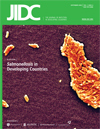Comparison of beta-lactamase genes in clinical and food bacterial isolates in India
DOI:
https://doi.org/10.3855/jidc.550Keywords:
Food-borne bacteria, antibiotic resistance, CTX-M, TEM, SHV, AmpC, beta-lactamasesAbstract
BACKGROUND: The present study aimed to determine the occurrence of human disease-causing enteric bacteria on raw vegetables, fruits, meats, and milk products sold in Indian markets. The study further aimed to analyze antibiotic resistance rates and the presence of blaCTX-M, blaTEM, blaSHV, and blaAmpC. METHODOLOGY: Twenty-three food-borne and 23 clinical isolates were compared for antibiotic resistance rates and the presence of blaCTX-M, blaTEM, blaSHV, and blaAmpC. Swabs were taken from unwashed and washed food items, as well as from some chopped food specimens, and inoculated on appropriate culture medium. Bacterial isolates were identified, antibiotic susceptibility was performed, and bla genes were detected by PCR. RESULTS: Thirty-eight bacterial isolates were obtained from the food specimens, of which 36 (94.7%) were Gram-negative and two (5.3%) were Gram-positive bacterial species. Klebsiella pneumoniae was the most prevalent (52.6%; 20/38) bacterial species isolated, followed by Citrobacter koseri (18.4%; 7/38). In food isolates, the majority of the isolates were resistant to gentamicin (33.3%) followed by amikacin (11.1%). Resistance to a third-generation cephalosporin was noticed in only 5.6% isolates. However, in clinical isolates, maximal resistance was noticed against third-generation cephalosporins followed by ofloxacin in 91.3% and 86.9% isolates, respectively, and resistance to gentamicin and amikacin was noticed in 78.3% and 52.2% isolates, respectively. The presence of blaCTX-M, blaTEM, blaSHV, and blaAmpC in clinical isolates was noticed in 52.2%, 60.9%, 21.7%, and 43.5%, respectively. None of the isolates from food showed the presence of any of the above-cited genes. CONCLUSIONS: Probably bla genes have not yet disseminated to raw-food vegetation in India.Downloads
Published
2009-09-15
How to Cite
1.
Shahid M, Malik A, Adil M, Jahan N, Malik R (2009) Comparison of beta-lactamase genes in clinical and food bacterial isolates in India. J Infect Dev Ctries 3:593–598. doi: 10.3855/jidc.550
Issue
Section
Original Articles
License
Authors who publish with this journal agree to the following terms:
- Authors retain copyright and grant the journal right of first publication with the work simultaneously licensed under a Creative Commons Attribution License that allows others to share the work with an acknowledgement of the work's authorship and initial publication in this journal.
- Authors are able to enter into separate, additional contractual arrangements for the non-exclusive distribution of the journal's published version of the work (e.g., post it to an institutional repository or publish it in a book), with an acknowledgement of its initial publication in this journal.
- Authors are permitted and encouraged to post their work online (e.g., in institutional repositories or on their website) prior to and during the submission process, as it can lead to productive exchanges, as well as earlier and greater citation of published work (See The Effect of Open Access).








